It’s 5:30 on a Monday night, and 10 graduate students and postdocs in bioengineering are crawling around on the basement floor of Stanley Hall. The activity has nothing to do with cellular behavior or biomedical instruments, two priorities of their lab. Instead, they are developing a dance theater piece, liberally based on how white blood cells engulf cancer cells, for their department’s annual art show. Mutants and Macrophages: The Musical — think Thriller meets West Side Story — is as much an exercise in creativity and delight as it is an opportunity to escape, for a few hours each week, the demands of a high-pressure research lab.
This is just one example of how Berkeley buzzes nonstop with creative life. There are the obvious places: A capella singers luring passersby on Sproul Plaza with catchy pop remakes. Students studying photojournalism, dance, architecture, writing, or dozens of other disciplines in the art or design fields. Over 70 official clubs connecting students to their artistic pursuits. Rock concerts at the Greek Theatre and ballets at Cal Performances.
And yet, true to form, our creative culture goes far beyond the obvious. “Berkeley truly knows what it means to elevate creativity for the greater good,” says Shannon Jackson, associate vice chancellor of arts and design.
The following stories share examples of how the arts can give voice to people on the edge of mainstream society. We learn about efforts to widen the circle of creators and viewers. We see how traditional crafts can reshape long-held perceptions, and how new technologies can bring a fresh perspective to common problems. And we witness the arts as a transmogrifier of challenging or painful experiences into something beautiful.
Rather than confining the art and design fields within their strict disciplines, Cal is blurring the lines to form a landscape where even bioengineers can dance.
Alvaro Azcarraga ’18 discovered two passions in high school. “I found myself drawing in science class and doing science homework in art class,” he recalls.
As a citizen of both the United States and Mexico, he was accustomed to a binary life — from differences in language, food, and social norms to the homes he had lived in: wood frame in America, clay brick in Mexico.
He carried this dualism to UC Berkeley, not expecting to find a bridge between his worlds. “Art practice allowed me to bring art and science together in a cultural context, relevant to my personal experiences,” says Alvaro, who graduated with a double degree in molecular and cell biology and art practice. “I had planned to be a doctor but found I was happiest doing science-related artwork.”
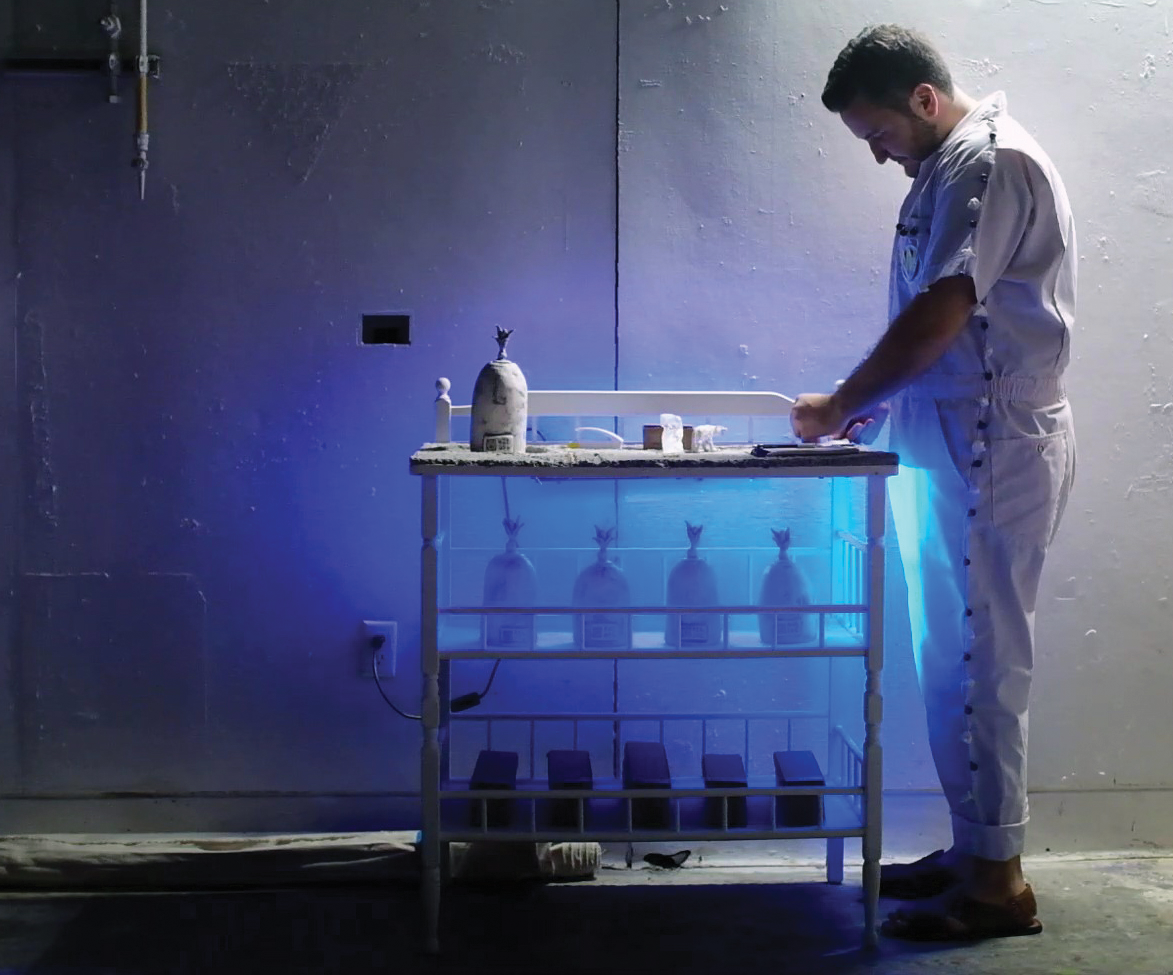
Alvaro Azcarraga ’18
He also found success. His provocative undergraduate thesis project — an installation and performance piece set in a fictional corporate research lab called SEMO — earned him a coveted spot at a San Francisco art co-op and a graduate fellowship to UCLA.
SEMO, which means “seed” in Esperanto, explores the growing dissonance between traditional ways of subsistence farming and high-tech commodification and control of food systems. Corn is a recurring symbol in his pieces, and he mixes natural materials, such as clay, with 3D-printed components made of plastic to reflect the hybrid forces at work across cultures and spheres.
“I have never fit into a specific category,” says Alvaro. “But at Berkeley, I grew comfortable with my dual identity.”
For Christina Azahar, a Ph.D. student in ethnomusicology, music festivals are more than a good time. She recently returned to Berkeley after a year as a Fulbright Fellow in Chile, conducting research for her dissertation on the intersection of feminism and popular music.
Arriving in January 2018, Azahar witnessed a massive strike by Chilean university students seeking to transform an academic atmosphere of machismo into one of inclusivity. Student activism in response to the high cost of education has been on the rise since 2006, but this strike had a particularly feminist bent, with roots in NiUnaMenos, the South American movement protesting sexual harassment and violence against women.
“Looking back at the progressive movement [of the 60s and 70s], feminist issues were not addressed,” says Azahar, who first went to Chile as an undergraduate to study nueva canción, the protest music of that era. Witnessing the strike, Azahar realized that she had chosen a perfect moment to examine the rise of Chilean music festivals by and for women. In her fieldwork, Azahar discovered a distinctive approach to organizing, producing, and staging.
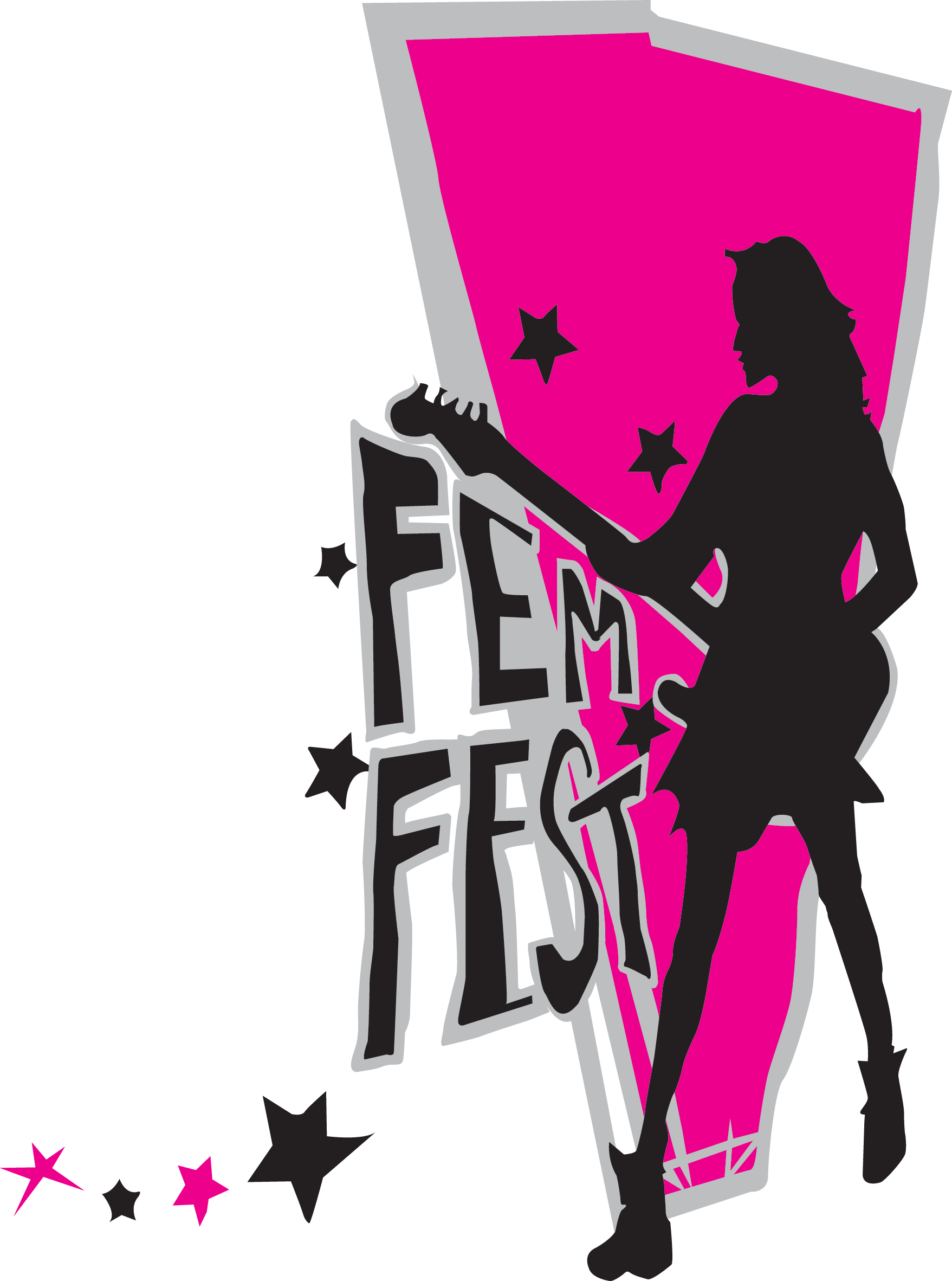
FemFest uses a music festival to train women in running sound.
Azahar met the organizers of Coordinadora Femfest, which offers a course that trains women to run sound, using a music festival as the students’ practicum. “They do everything,” says Azahar, noting that Femfest has avoided outside funding, which is freeing, but requires year-round work. Azahar says Femfest’s collaborative approach “changes the way that people see music can be done” and catalyzes community efforts to create a more equitable society
“The Black Arts Movement [of the 1960s] understood itself as an extension of the black liberation struggle,” says Malika Imhotep (left). “[Writer] Toni Cade Bambara said the duty of the writer is to make revolution irresistible — I see myself as part of a creativity that was always intentioned for the public good.”
Imhotep and Jamal Batts (right), doctoral candidates in African American studies, along with Oakland-based artist Leila Weefur (middle), run a curatorial collective, The Black Aesthetic (TBA), that Weefur describes as creating “new discourse around black cinema and visual culture.”
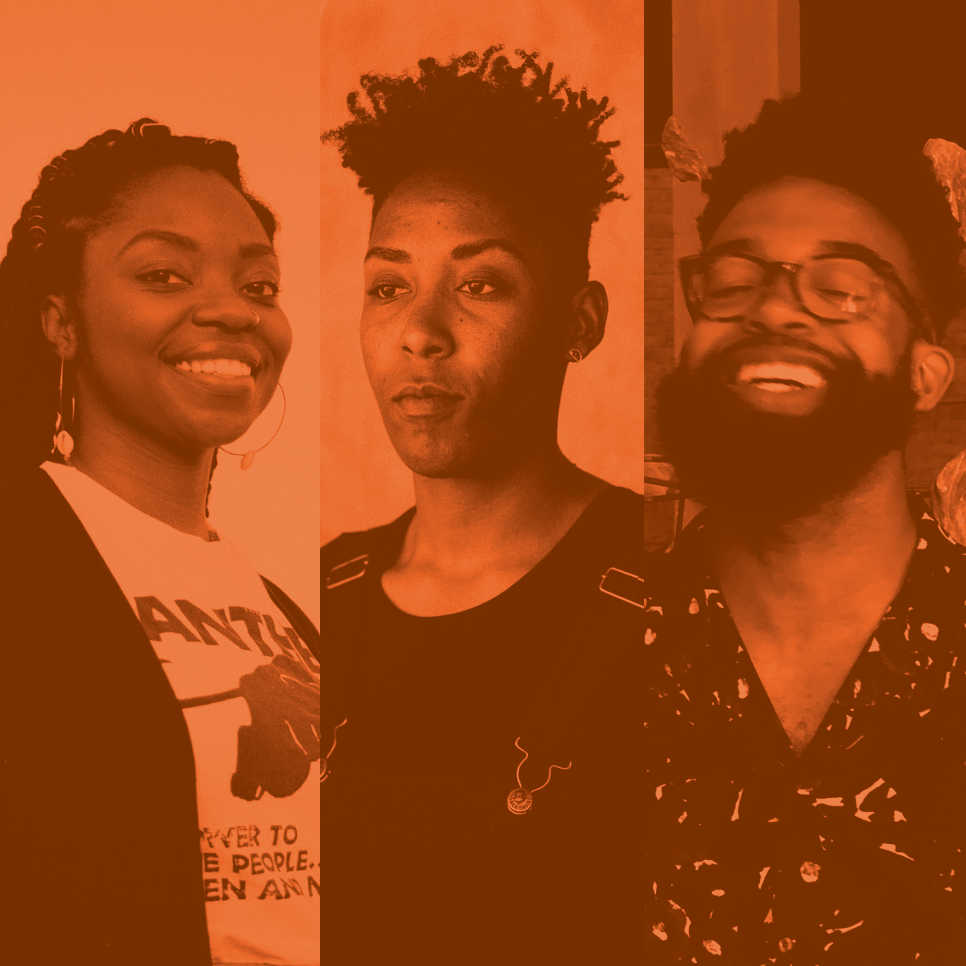
Malika Imhotep, Leila Weefur, and Jamal Batts
Since 2016, TBA has been gathering community at E.M. Wolfman — a bookstore and arts hub in downtown Oakland — to screen films and interrogate assumptions about race, identity, and society. While Oakland faces challenges to its legacy as a center of black culture and political action, TBA serves as a creative response to a mainstream culture that offers very limited exposure for the work of black artists.
“We try to invite as many voices to the table as possible,” says Batts, noting they occasionally screen films by non-black filmmakers.
The collective publishes criticism, poetry, personal essays, and photography inspired by the films they screen and discuss. In 2018, TBA hosted an overflowing crowd for a screening at the Berkeley Art Museum and Pacific Film Archive, which subsequently invited the group to select rarely seen films for a series called “Black Interiors.” Focusing on work, spirituality, intimacy, and other aspects of black lives, the series explores what it means to be a human being in general and a black person in America in particular.

Origami is just one activity CREATE students teach.
It’s not news that many U.S. schools are slashing funding for arts education, despite the fact that the arts are proven to boost critical thinking and increase test scores. Enter CREATE (Creative Residencies for Emerging Artists Teaching Empowerment) — a student-led group that teaches visual arts, theater, dance, and/or creative writing in local organizations. CREATE pairs students with teaching artists, who mentor them on subjects such as how to design a curriculum and age-appropriate activities.
As a first-year student, Alex Cabana ’19 stumbled upon CREATE’s table at the Calapalooza activities fair. Eight semesters later, as a graduating senior, she’s still teaching weekly classes. Each semester she’s assigned to a different site — from elementary and middle schools to the Berkeley Food and Housing Project, whose adult clients struggle with housing instability — and has taught collage, vegetable stamping, origami, clay, and watercolor.
The students, in turn, inspire Cabana. One adult student worried that she wouldn’t be able to do origami by herself. “But after we worked through the project together, step by step, she was able to produce her own version,” Cabana says.
“Art class expands our technical abilities but, more importantly, it… allows us to show ourselves how capable we really are.” — Alex Cabana ’19
Cabana had originally planned to become an architect. But her experience with CREATE has prompted her to shift toward searching for a job in museum education. “Often a student will ask if they can take a project in a new direction or incorporate a new material,” Cabana says. “It’s my favorite question — because the answer is always yes.”
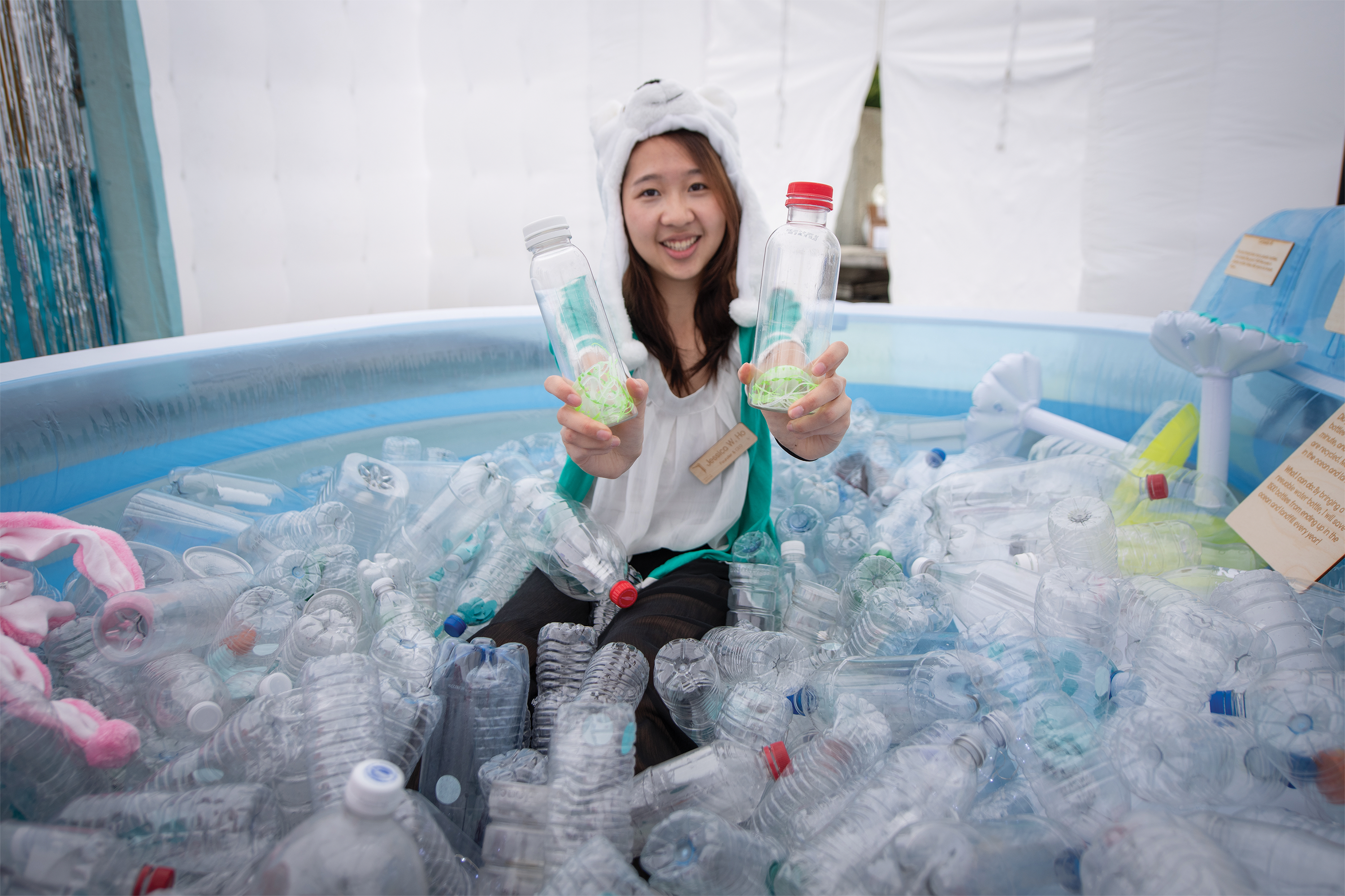
The Museum of Tomorrow featured a pool filled with plastic bottles. Photo: Keegan Houser
Combine an overwhelming issue like climate change with Instagram-era engagement, and you get the Museum of Tomorrow. The brainchild of Jessica Ho M.D.P. ’19, this traveling pop-up views a potentially depressing topic as a way to prompt positive behavior choices, one selfie at a time.
“Climate change is portrayed with a lot of gloom and doom,” says Ho. “I want to change that.”
Inspired by discussions in a class on sustainability and society — and encouraged by the popularity of photo-oriented attractions like the Museum of Ice Cream — Ho and four fellow master’s students in development practice, along with colleagues in business and engineering, set out to conceive engaging exhibits that conveyed a serious message.
A million plastic bottles are bought around the world every minute — outstripping recycling efforts and jeopardizing oceans and other environments. What can you do? Buy a reusable water bottle. (Source: The Guardian, June 28, 2017)
During the Museum of Tomorrow’s weeklong debut in April, visitors could don virtual reality headsets for a gamified immersion in ocean acidification, bob in a pool with hundreds of plastic bottles in search of matching jellyfish, or see the environmental impact of food and fashion decisions. They could also win a reusable beverage container or make a public pledge to reduce their individual impact.
“The most urgent need right now is to educate people my age,” says Ho. “Even if they might not care about climate change, they all want to take pictures at a public museum.”
How do objects reflect cultural moments — and why do we value what we value? These are among the questions that Stephanie Syjuco, assistant professor in art practice, explores in her conceptual art. And no medium is off-limits: Throughout her career, she has combined handcrafts such as woodworking and sewing with photography, video, and other digital technologies to create large-scale spectacles of cultural objects, often inviting viewers to directly participate as producers or distributors.
Syjuco’s internationally known projects investigate issues of economies and empire by leveraging open-source systems, shareware logic, and flows of capital. Starting a global collaboration with crochet crafters to bootleg high-end handbags, for example. Or developing alternative vending economies in a pop-up store.
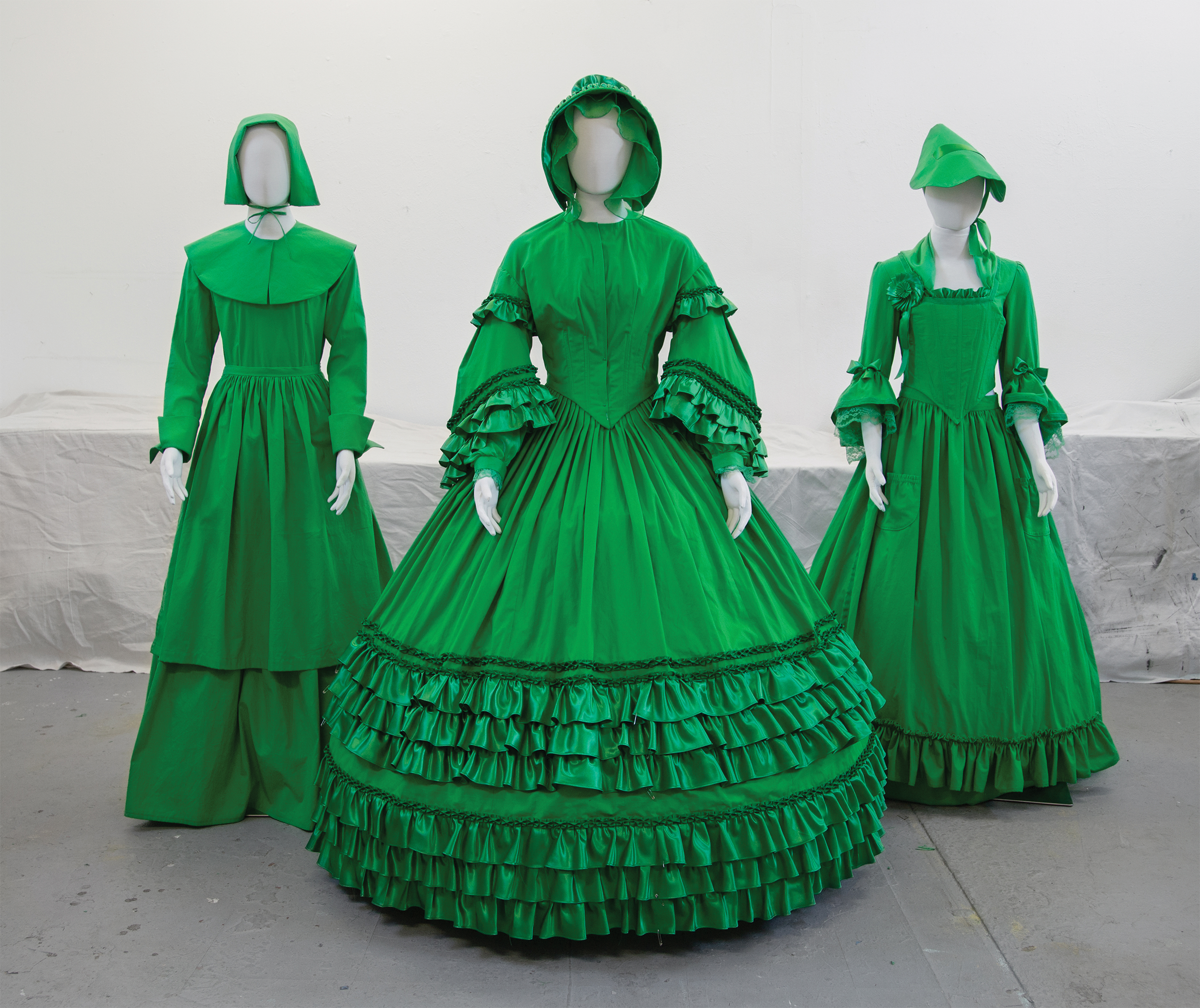
Three dresses featured in Stephanie Syjuco’s exhibit The Visible Invisible. Photo: Jin Zhu
In The Visible Invisible, an exhibit at the Smithsonian American Art Museum, three meticulously crafted dresses represent the Pilgrim, American Revolution, and Civil War eras. They are chroma key green, the eye-catching color used as a backdrop for cinematography that allows moviemakers to digitally superimpose their subjects on different backgrounds. Ironically, the green is “deleted” using computer software.
“There are hidden histories and power structures in these crafted garments,” Syjuco says. “At first, the clothing is seductive to the viewer — everyone loves the handmade detail — but there’s a flip side to that beauty.”
The American Revolution is celebrated as the birth of American democracy, “But it only focused on the freedoms of white men, literally,” says Syjuco, a 2014 Guggenheim Fellow whose work is featured in many prestigious museum collections. “Slavery was legal, and women were not given the vote until a century and a half later.”
While we live in a physical world, our interactions are driven increasingly by digital means: Almost everyone is looking down at their phones or other devices. Augmented and virtual realities (AR/VR) challenge our relationship with technology by breaking the barriers between the physical and virtual realms. Whereas AR enables us to envision real spaces in new ways, VR places us inside imaginary worlds.
These technologies have been taught at Berkeley since the ’90s, but today they’re exploding on campus — thanks largely to Virtual Reality at Berkeley (VR@B), one of the biggest student clubs of its kind in the United States. The club gives students access to equipment and training and supports teams in developing new applications, investigating how AR/VR could change the nature of education, entertainment, medicine, and more. Here are just a few projects born at Cal.
Helping blind people find their way
Navigating new spaces can be a cumbersome or frustrating experience for blind people as they listen and feel their way around. A team of master’s students in the School of Information is using AR headsets to scan a user’s surroundings, then map and sonify obstacles up to five meters away. The headsets can also read text aloud, helping users ensure they are in the right place. The project could give visually impaired people greater independence in performing basic tasks like finding a bus stop.
A 21st-century science center
The Lawrence Hall of Science is both a hands-on science center for kids and a training ground for teachers worldwide. The hall’s new learning labs team is researching ways to amp up AR/VR within the museum and, ultimately, for STEM learning in classrooms and the broader community. It’s partnering with Berkeley engineers to develop a VR-enhanced exhibit on marine ecology and is exploring how to make the experience more kid-friendly, since the technology has only been tested on adults.
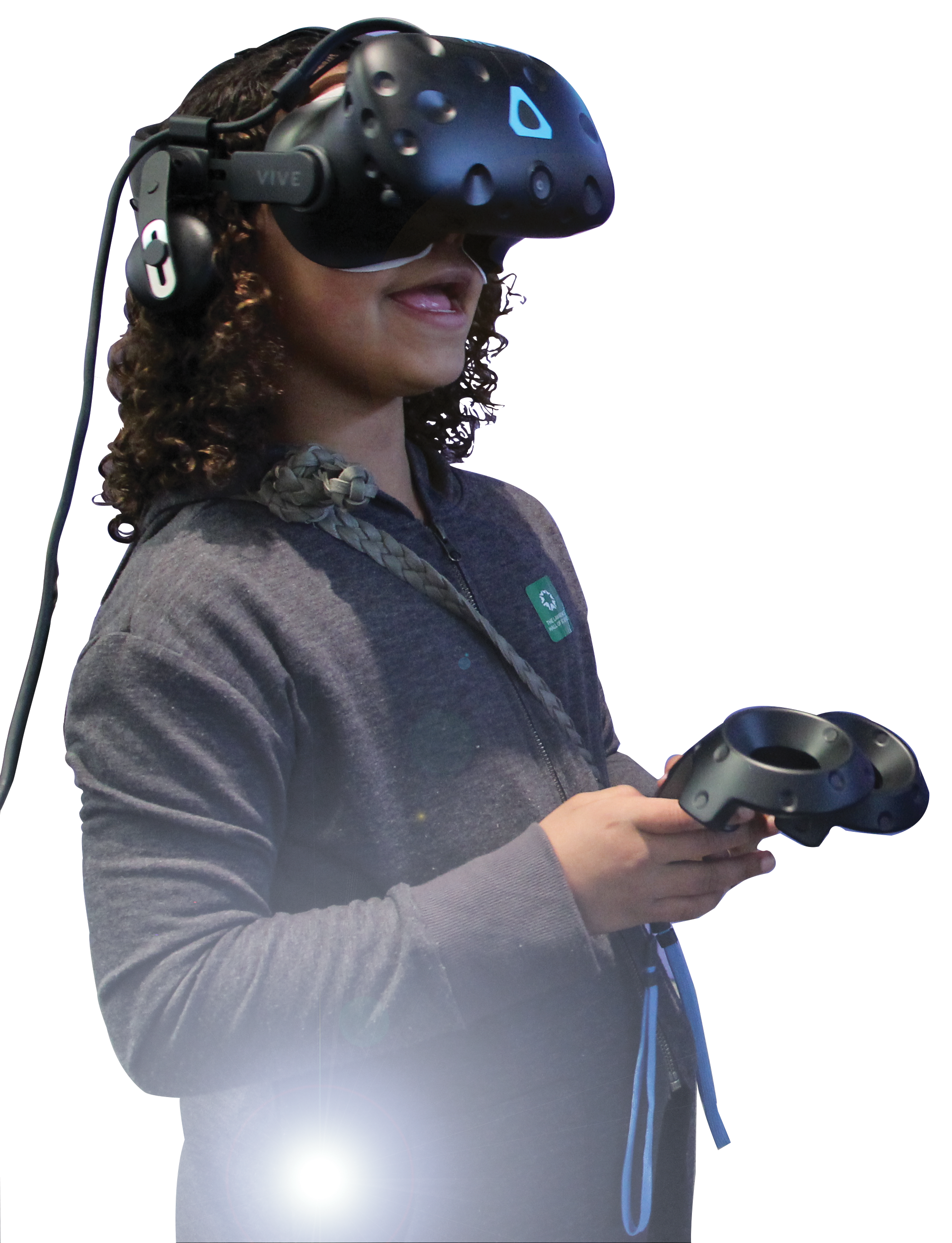
A child wears an AR/VR headset.
Getting inside the story
As media are increasingly using AR, VR, or a hybrid of both, we are witnessing a revolution in storytelling. Journalism alumni Lakshmi Sarah M.S.J. ’16 and Melissa Bosworth ’05, M.S.J. ’16 recently cofounded a production company that uses 360-degree video to immerse viewers inside stories, providing a powerful marriage of information and empathy. One story produced for San Francisco’s KQED-TV follows three homeless people on their daily quest to stay safe, fed, and clean while maintaining a sense of dignity. The pair recently published a book, Crafting Stories for Virtual Reality.
Play ball with the Bears
While sports fans can watch almost anything they want whenever they want, VR is providing a more intimate experience than previously available. Kris Hsu ’19, an undergraduate studying cognitive science and film, produced Cal Athletics’ first-ever 360-degree video featuring Cal’s football victory over UCLA. Bears fans may soon be able to go behind the scenes at a men’s basketball practice or meet the women of soccer, enabling them to enjoy Cal sports long after the court or field has cleared.
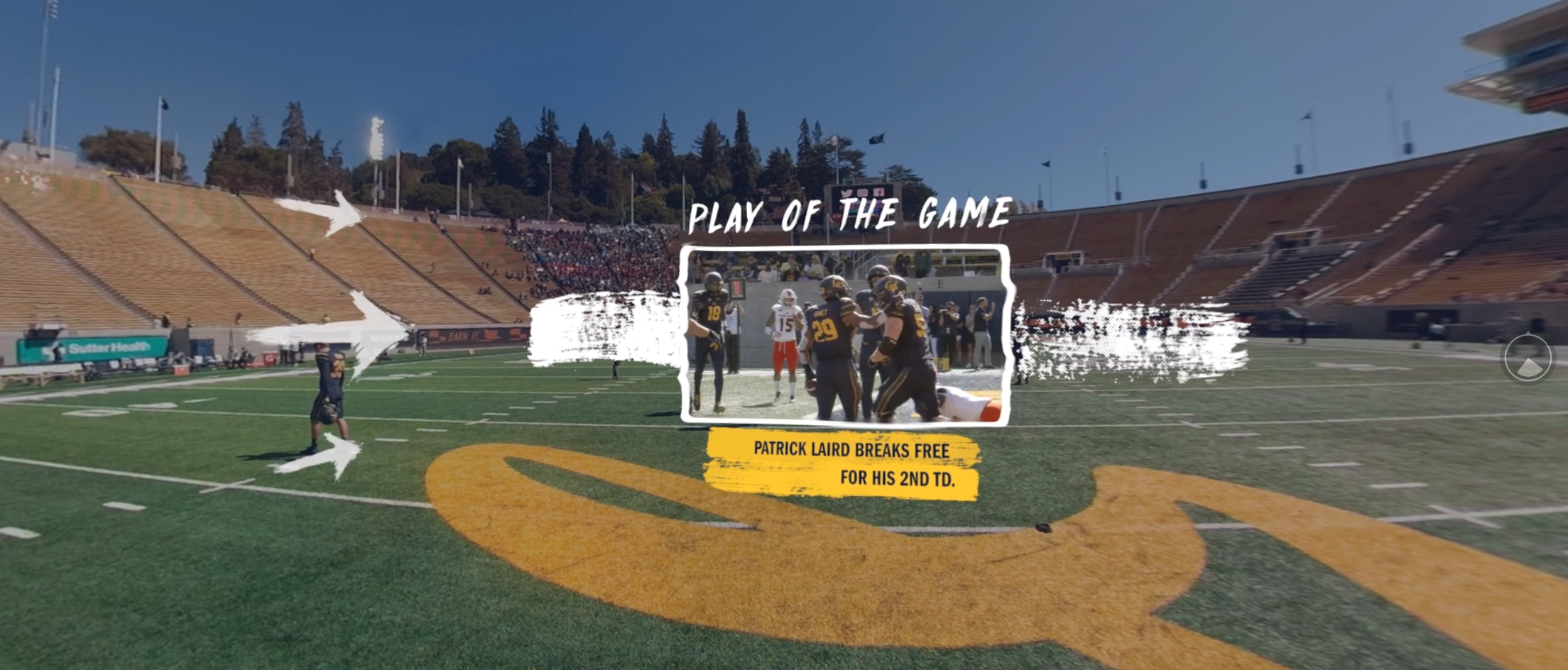
360-degree video by Kris Hsu ’19
Harnessing the power of the mind
Biofeedback, in which patients learn how to control their heart rate and other functions that respond to stress, is effective in treating anxiety and other conditions. Undergraduates Shreya Sudarshana and Joshua Yang are leading a student team to create a VR game that could transform biofeedback from a clinical treatment to a healing activity one can do alone. Brain waves control the growth of an animated flower, and the user becomes more relaxed the higher the flower grows. The team is adding more bodily functions and other capabilities and hopes to develop a consumer-friendly version.
AR/VR: What’s the difference?
Augmented reality (AR) —Real-world environments that are overlaid, or augmented, with location-specific information and graphics. Example: Apps that help you visualize furniture in your home.
Virtual reality (VR) — Immersive, computer-generated environments that simulate vision, hearing, touch, and other senses. Example: 3D visualizations of internal organs to help surgeons plan complex operations.
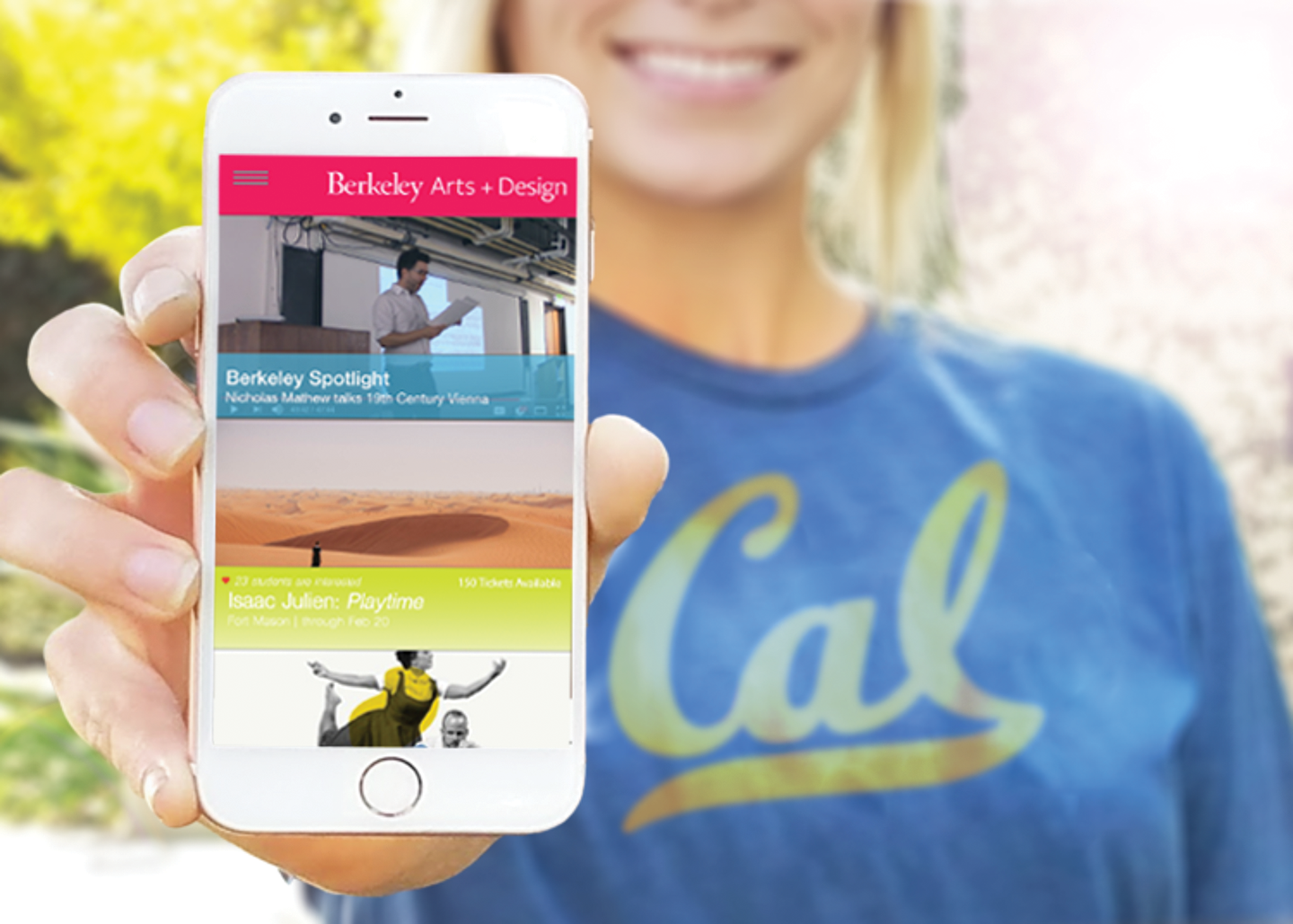
A student shows off the Arts Passport.
As a chemistry major also studying art, Luna Izpisua Rodriguez ’16, M.Eng. ’18, sensed that something was missing. Despite being surrounded by a wealth of Bay Area arts organizations and events, she and her friends weren’t taking advantage of them. “We didn’t know what was going on, or how to get there, or didn’t want to go alone,” she recalls.
Later, as a master’s student at the Fung Institute for Engineering Leadership, Izpisua Rodriguez decided to do something about it. Partnering with Berkeley Arts + Design, she assembled a graduate student team to develop a mobile app that connects Cal students to the local arts scene. The team interviewed hundreds of students about their interests and experiences to inform the app’s design.
The Arts Passport gives students access to free tickets to exhibitions, performances, and events, as well as enables them to share their experiences with friends. Participating organizations include SFMOMA, Oakland Museum of California, and Yerba Buena Center for the Arts, as well as the university’s art and anthropology museums and botanical garden. In addition, donors can fund opportunities for students.
While technology and art are often seen as separate schools of thought, Izpisua Rodriguez believes both are deeply rooted in exploration, play, and curiosity. Now the app is sparking others’ curiosity.
Officially launched on Cal Day 2018, the Arts Passport had 14,000 users in its first week and continues to grow in users and offerings — a testament to how technology can heighten our personal experience of art, as well as connect us to others who share a love for the arts.
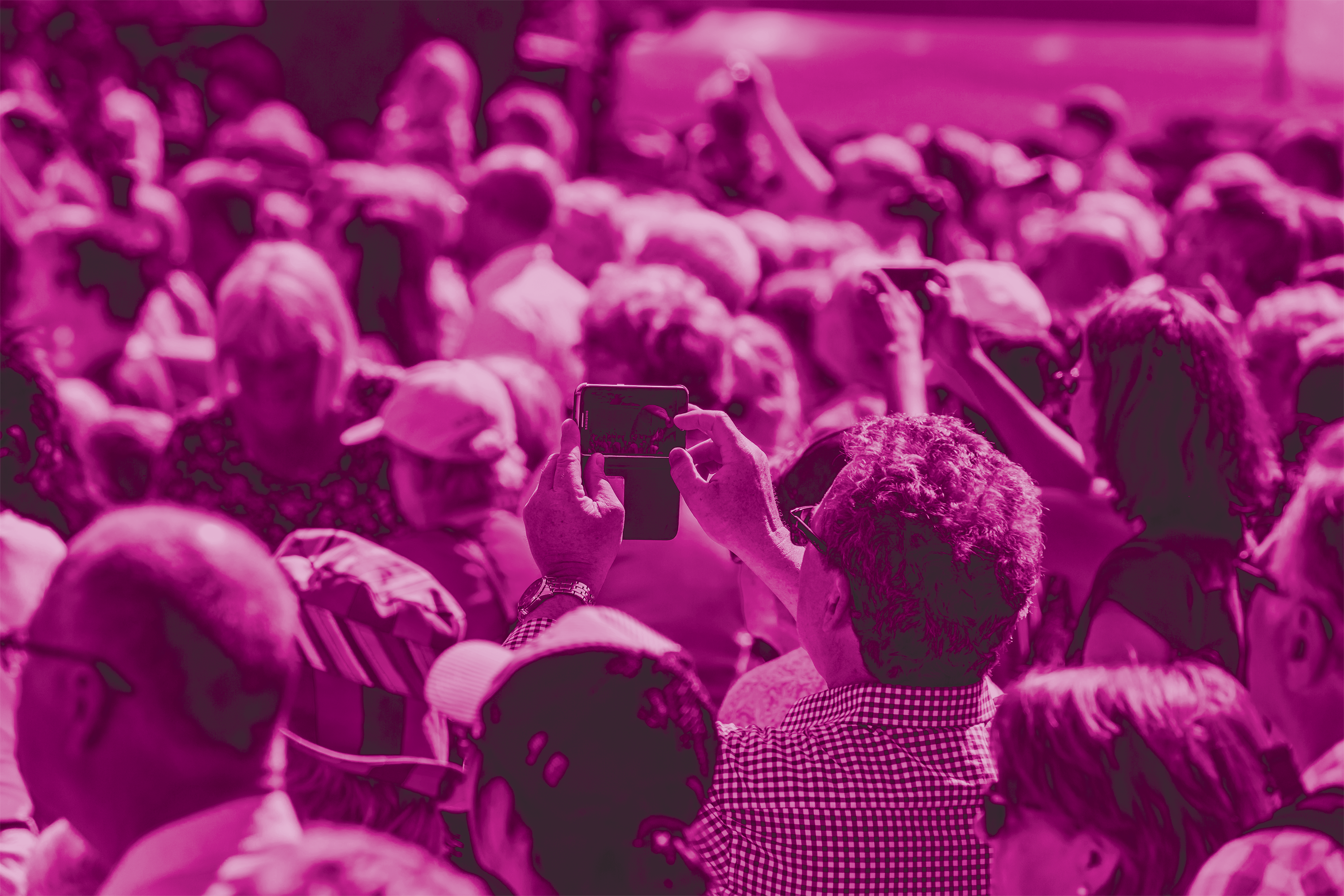
Access to media has changed the way we interact with the world.
With 25 faculty from 23 departments, the Berkeley Center for New Media (BCNM) is an interdisciplinary research, teaching, and public events program that studies new media from the perspectives of the humanities, arts, and technology. We spoke with Nicholas de Monchaux, BCNM director and associate professor of architecture and urban design.
Why does Berkeley have a center focused on new media?
Media is changing radically, and our society is changing with it. The conversation about new media is critically important to help us think about the world, political structures, technology, child development, news coverage, and more. Now the main commodity is not access to media. It’s our attention — we only have so much time to give.
How has your work impacted the general public?
In 2017, there was a big conflict about free speech when conservative commentator Milo Yiannopoulos was scheduled to speak. A week later, BCNM hosted a campuswide symposium that addressed the history, practice, and spaces of free speech within the university. A week before the 2018 midterm elections, we held another symposium to explore the effect of social media on political campaigns and the role of software algorithms in gerrymandering to artists and activists in unconventional media. We’re responding to such issues in real time.
What are your thoughts about the future of journalism?
The “golden age of journalism” was the product of a previous ecology. Information is now free, so we must develop new, economically sustainable models of journalism. But far more threatening, I think, is the way in which the contemporary media landscape has fractured into separate tribal stories around what is happening in the world. Talking across differences is the most… essential way to produce innovative thinking, and the future’s going to need it.
In AGO, the newest play by Stan Lai Ph.D. ’83, a group of survivors seek a mythical Pure Land. Inspired by both ancient Buddhist scriptures and by modern life — and moving between the Tibetan plateau and New York — the story explores humankind’s perennial quest for transcendence, as well as its predisposition to folly.
More than 40 undergraduate students collaborated with Lai to organically create the play, serving as actors, playwrights, directors, designers, and technical support. They used improvisation to develop the script for four acts and performed the first two acts in April.
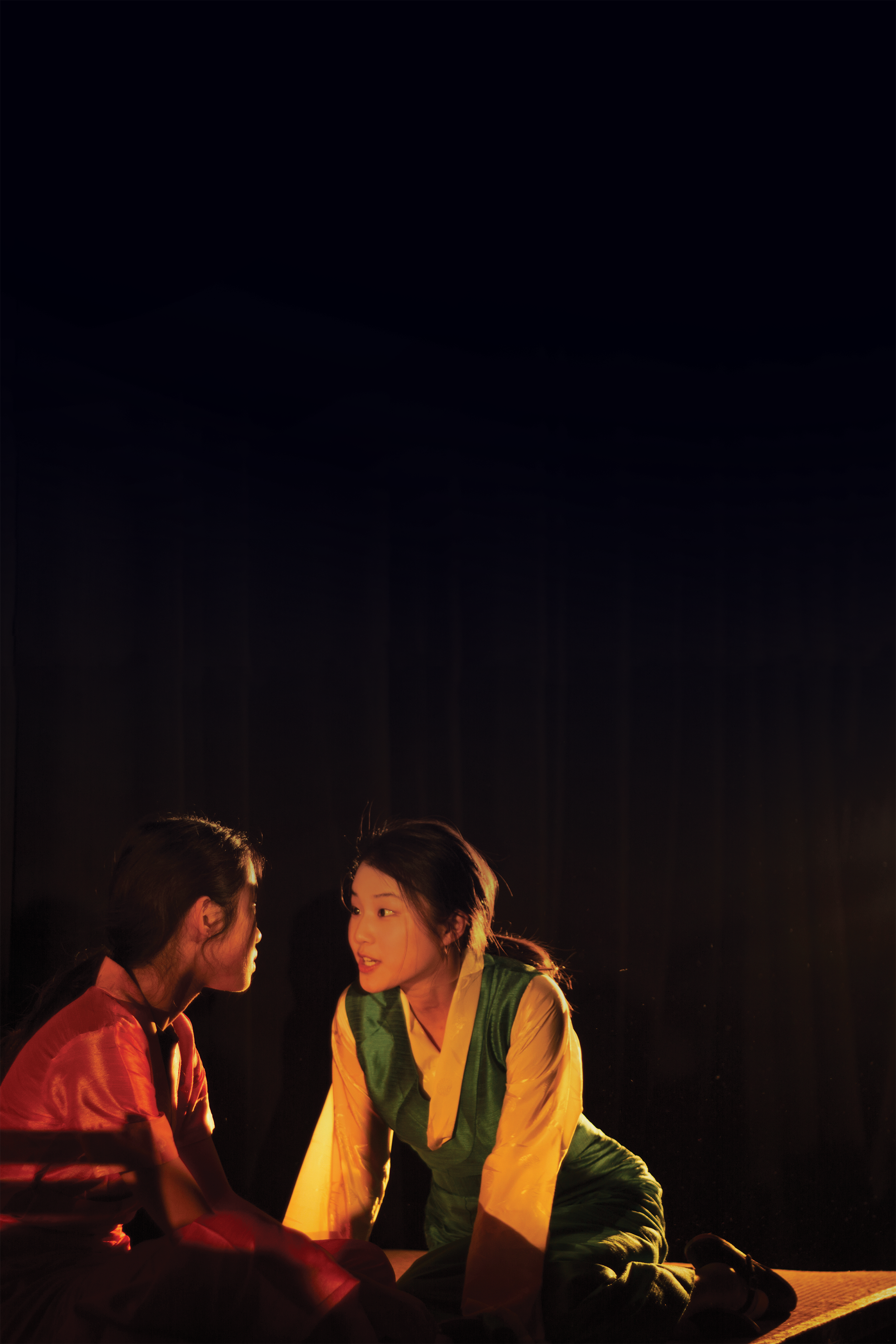
Students perform in AGO, a play by Stan Lai Ph.D. ’83. Photo: Malachi Tran
Molly Nicholas, a third-year Ph.D. student in computer science, worked on the production’s sound and augmented reality (AR) features. Several aspects of the show, including the program and the poster, were enabled with AR to enhance the audience experience.
“The general challenge of academia is the distance between the study of a process and actual practice,” says Nicholas. “This was a chance for students to experience a deeper engagement of practice. No lectures, no theory, just doing it like the professionals.”
Since studying dramatic arts at UC Berkeley, Lai (Lai Sheng-chuan) has authored more than 30 plays and a best-selling book on creativity in Taiwan and China. The BBC has called him “the best Chinese language playwright and director in the world.”
Lai, an artist in residence with Berkeley Arts + Design, introduced high-tech elements to AGO, “but I was more interested in a grander vehicle — the human imagination,” he says. “We transported our audience to different places through the workings of their own minds."
For John Hildenbrand ’19, discovering that he could enroll in college without having an address was a revelation. Homeless for several years after losing his job, he enrolled in community college in his mid-40s. After transferring to Berkeley at age 49, he discovered that his experience could be a starting point for creative and social service projects he will continue long after graduation.
“The best people to help the community are the members of the community,” says Hildenbrand, who studied theater, dance, and performance studies, as well as American studies. He originally thought he would major in sociology, but his mentors persuaded him to pursue performance as a tool for social change. He wrote and performed a one-man play about his unsheltered years in Los Angeles, Restroom for Customers Only.
Stepping into his newest role, Hildenbrand will travel this summer from the Golden Gate Bridge to the Brooklyn Bridge on his electric skateboard. Accompanied by a partner in a van, he hopes to raise awareness about homelessness and his new nonprofit, the Dick Hildenbrand Foundation for Academic Reentry.
“Now is the time to get homeless adults educated,” says Hildenbrand, noting that the foundation, named after his father, will help adults discover resources that can support their transition from the streets to the classroom and beyond. The foundation fills a critical void: Most organizations like it focus on youth. Even Hildenbrand’s theater thesis — “From the Streets of Despair to the Halls of Education” — reflects the journey he seeks to inspire others to take.
